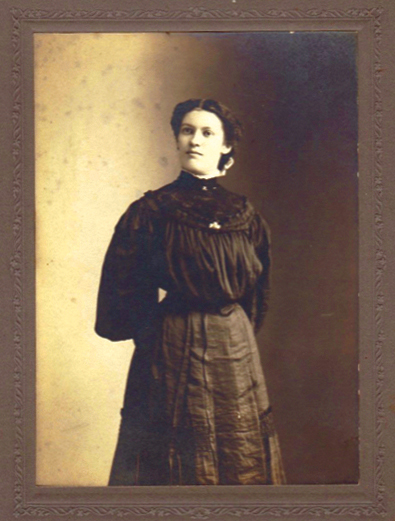The Unknowns by Maureen Culbert
Family Photos, Geneology Are
Mysteries Waiting To Be Solved

At a recent garage sale in Cooperstown, I purchased an old frame with a woman’s photo in it. Not known to the seller, he said to me, “instant relative.” As I returned home, I got to wondering about the woman and her story, which of course has been lost to time. She is part of the “unknowns,” and our historical society, like many others, has numerous photos of people who, like her, are in limbo from lack of identification.
I love garage-saling and will, from time to time, see photos like this on a table for sale. I usually go over and encourage the folks to look deeper and perhaps donate the photos to their own historical society. The identifiers on the photos can provide clues—a hand-scribbled name, or a location of a photo studio—neither of which this photo has. Now we have to get out the magnifying glass and see if there is a pin, button or perhaps another clue to her identity, such as a ring. There are no “props” in the photo I purchased, and she wears a plain hairstyle, pulled back. She’s dressed in black, so this could be a photo taken after the passing of her husband. She has her jaw set in a determined manner, and we can only guess at her personality. The woman appears to be about 30 years of age. Her clothing indicates the early 1900s, perhaps. That’s about it.
We can only guess at her story. Did she remarry? Why is she hiding her hands? Are they perhaps worn with hard work or sewing, to make ends meet? Did she have a connection to the family who sold the frame, or did she just end up there as a result of some other connection, perhaps to her husband’s family? So much is unknown, and a mystery which may never be solved.
The Internet provides a lot of tutorials and examples of period clothing to help date photographs, but dating can also be done by examining the photograph itself. Daguerreotypes, silver clad copper sheets, date from 1839 to the 1850s.
The use of ambrotypes, photos printed on glass plates with iodized collodion, begin about 1854 and tintypes, those on iron plate instead of glass, were used from 1856 to about the 1870s (and up to the early 20th century as a novelty).
Carte de visite photographs, thin paper mounted on a thicker paper card, were available after 1859.
Thanks to the advent of DNA testing, genealogy is now one of the most popular hobbies in the United States. People are finding lost relatives, and adopted family members, via DNA by connecting on Ancestry.com.
Family photos and genealogy are mysteries just waiting to be solved. For the most part, though, we eventually reach a “brick wall” where we can go no further, for one reason or another, without incredible persistence. The best thing to do is to start with what you know, develop a paper trail outlining what you were told or believe, then work backward—recognizing that some family “lore” is true and some isn’t—and be open to the outcome.
Today’s photos are mostly all digital, taken with a phone and saved onto someone’s computer. Before the advent of the cell phone, we took physical photos and pasted those in a book which was dragged out periodically and enjoyed.
Those days now seem a part of the distant past.
What will your legacy be to future generations? Will you have photos preserved or thrown in a box with no markings, only to end up at a yard sale or in the trash?
If you have old photographs and would like your local historical society to have access to them, you can have those photos scanned, keeping the originals and providing copies on a disk or thumb drive for the society’s use. The local historical society can also keep a record of your basic genealogy, if you have one. Most libraries provide access to the Ancestry Library Edition and you can provide a basic genealogy to your historical society to assist others in their search for lost family members. Cemetery and church records are increasingly being digitized and made searchable online to show where folks are buried. Often entire families were laid to rest in family plots, which aids in identifying children and even nearby in-laws.
We are all searching for something more about ourselves. Where did our ancestors come from and what prompted them to cross the ocean, many of them stuck in steerage for months? They left family behind in the old country, perhaps never to see them again. They left famine, fear, political oppression, religious persecution and war behind to build a better life in America. Knowing and preserving their story is important and—while you’re at it—you can shape your own.
Maureen Culbert is vice president of the Springfield Historical Society.

